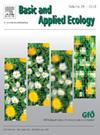在授粉之外-被忽视的地面筑巢蜜蜂对土壤功能的贡献
IF 3.5
2区 环境科学与生态学
Q2 ECOLOGY
引用次数: 0
摘要
虽然野生蜜蜂提供的授粉服务现在已经得到了很好的认识,但它们作为土壤生态系统工程师的重要性在很大程度上被忽视了,尽管大多数物种在自挖的洞穴中在土壤中筑巢。本文综述了地面筑巢野生蜜蜂对土壤物理、化学和生物特性、土壤功能和生态系统服务的直接和间接影响。特别是,我们讨论了地面筑巢蜜蜂如何在筑巢过程中移动和混合大量土壤,从而改变土壤的物理性质(例如,土壤孔隙结构,土壤孔隙度,密度)和土壤功能(例如,水和气体交换),并在更大范围内充当地貌因子(例如,影响地表径流和土壤侵蚀)。我们还回顾了地面筑巢蜜蜂如何通过筑巢活动影响土壤的化学和生物特性,导致土壤中有机碳和营养物质的重新分配和积累,为微生物活动提供热点,并将一系列生物引入土壤。此外,我们还讨论了植物的传粉功能对土壤的大规模间接影响,包括植物群落的形成和植物对土壤功能的调节。最后,我们强调了地面筑巢蜜蜂作为土壤生态系统工程师的作用,它们在空间和时间上补充了其他生物扰动器的活动,占据了其他生物扰动器基本缺失的生物地理生态位,并在季节期间补充了活动高峰。我们强调了地巢蜂在土壤动物中的独特地位,既是传粉者,也是土壤生物扰动者,并得出结论,地巢蜂作为土壤生物多样性的一部分,作为土壤生态系统工程师,在未来的研究和保护政策中应该得到更多的关注和认可。本文章由计算机程序翻译,如有差异,请以英文原文为准。
Beyond pollination – The neglected contribution of ground-nesting bees to soil functions
While the pollination services provided by wild bees are now well recognized, their importance as soil ecosystem engineers has been largely overlooked, despite the fact that most species nest in the soil in self-excavated burrows. Here we provide an overview of the many direct and indirect effects of ground-nesting wild bees on the physical, chemical and biological properties of soil, soil functions, and ecosystem services. In particular, we discuss how ground-nesting bees move and mix substantial amounts of soil during nest construction, thereby altering soil physical properties (e.g., soil pore architecture, soil porosity, density) and soil functions (e.g., water and gas exchange), and act as geomorphic agents at larger scales (affecting, e.g., surface runoff and soil erosion). We also review how ground-nesting bees affect soil chemical and biological properties through their nesting activity, leading to the redistribution and accumulation of organic carbon and nutrients in the soil, providing hotspots for microbial activity, and introducing a range of organisms into the soil. Furthermore, we discuss the large-scale indirect effects on soils through their pollination functions, which shape plant communities and soil functions modulated by plants. Lastly, we highlight the role of ground-nesting bees as soil ecosystem engineers that complement the activity of other bioturbators in both space and time by occupying biogeographical niches where other bioturbators are largely absent, and by complementary activity peaks during the season. We emphasize the distinctive position of ground-nesting bees among soil fauna, acting as both pollinators and soil bioturbators, and conclude that ground-nesting bees deserve greater attention and recognition in future research and conservation policy as part of soil biodiversity and for their role as soil ecosystem engineers.
求助全文
通过发布文献求助,成功后即可免费获取论文全文。
去求助
来源期刊

Basic and Applied Ecology
环境科学-生态学
CiteScore
6.90
自引率
5.30%
发文量
103
审稿时长
10.6 weeks
期刊介绍:
Basic and Applied Ecology provides a forum in which significant advances and ideas can be rapidly communicated to a wide audience. Basic and Applied Ecology publishes original contributions, perspectives and reviews from all areas of basic and applied ecology. Ecologists from all countries are invited to publish ecological research of international interest in its pages. There is no bias with regard to taxon or geographical area.
 求助内容:
求助内容: 应助结果提醒方式:
应助结果提醒方式:


